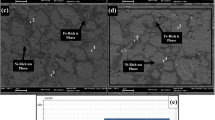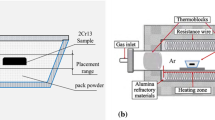Abstract
The high strength, elasticity, hardness and wear resistance of C17200 copper means it is widely used in motor brushes, bearing sleeves and contact parts. As the requirement for extended reliability and service life of industrial products increases, the demand for high-performance copper-beryllium (Cu-Be) will also increase. In this work, the wear mechanisms of C17200 alloy against GCr15 steel under dry conditions and in a 3.5% NaCl solution were investigated. X-ray diffractometry, scanning electron microscopy, energy-dispersive x-ray spectroscopy, a three-dimensional profilometer, and x-ray photoelectric spectroscopy were used to evaluate the wear damage and analyze the wear mechanisms involved. The results showed that the wear mechanisms of C17200 alloy under dry wear conditions were mainly adhesive wear, oxidation wear and delamination. During tribocorrosion, the effect of friction promoted the oxidation and corrosion of the specimen surface. The main wear mechanisms of tribocorrosion in a 3.5% NaCl solution were peeling and corrosion wear. In addition, the NaCl solution provided lubrication and could effectively reduce the wear of the materials. The results may guide improvement of the serviceability of Cu-Be materials in industrial environments.












Similar content being viewed by others
Data Availability
All data included in this study are available upon request by contact with the corresponding author.
References
K. Gurumoorthy and A. Ghosh, Failure Investigation of a Taper Roller Bearing: A Case Study, Case Stud. Eng. Fail. Anal., 2013, 2(1), p 110–114.
R.K. Upadhyay, L.A. Kumaraswamidhas and M.S. Azam, Rolling Element Bearing Failure Analysis: A Case Study, Case Stud. Eng. Fail. Anal., 2013, 1(1), p 15–17.
K. Krishnakumar and A. Selvakumar, Metallurgical Investigation of Failure Analysis in Industrial Machine Components, Mater. Today Proc., 2020, 27, p 2076–2080.
R. Collacott, Mechanical Fault Diagnosis and Condition Monitoring, Springer, New York, 2012.
A. Rezaei, W. Van Paepegem, P. De. Baets, W. Ost and J. Degrieck, Adaptive Finite Element Simulation of Wear Evolution in Radial Sliding Bearings, Wear, 2012, 296(1–2), p 660–671.
R. Kumar, S. Kumar, B. Prakash and A. Sethuramiah, Assessment of Engine Liner Wear from Bearing Area Curves, Wear, 2000, 239(2), p 282–286.
B.K. Prasad, Dry Sliding Wear Response of Some Bearing Alloys as Influenced by the Nature of Microconstituents and Sliding Conditions, Metall. Mater. Trans. A, 1997, 28(13), p 809–815.
X. Wang, Z. Yin and Y. Chen, Study on Fatigue Strength of SnSb11Cu6 Babbitt-Steel Bimetal Sliding Bearing Material Prepared by MIG Brazing, Mech. Ind., 2020, 21(1), p 106.
M. Stanković, A. Marinković, A. Grbović, Ž. Mišković, B. Rosić, and R. Mitrović. Determination of Archard’s Wear Coefficient and Wear Simulation of Sliding Bearings. (Industrial Lubrication and Tribology, 2019)
A. Vencl and A. Rac, Diesel Engine Crankshaft Journal Bearings Failures: Case Study, Eng. Fail. Anal., 2014, 44, p 217–228.
S. Chen, J. Li, L. Wei, Y. **, H. Shang, M. Hua and H. Duan, Tribological Properties of Polyimide-Modified UHMWPE for Bushing Materials of Seawater Lubricated Sliding Bearings, Tribol. Int., 2017, 115, p 470–476.
Z. Yang, Z. Guo and C. Yuan, Effects of MoS2 Microencapsulation on the Tribological Properties of a Composite Material in a Water-Lubricated Condition, Wear, 2019, 432, p 102919.
Z. Guo, C. Yuan, A. Liu and S. Jiang, Study on Tribological Properties of Novel Biomimetic Material for Water-Lubricated Stern Tube Bearing, Wear, 2017, 376, p 911–919.
P. Behjati, H.V. Dastjerdi and R. Mahdavi, Influence of Ageing Process on Sound Velocity in C17200 Copper-Beryllium Alloy, J. Alloys Compd., 2010, 505(2), p 739–742.
W.A. Glaeser, Materials for Tribology, Tribologyseries, Vol 20 Elsevier, Amsterdam, 1992, p 56–59
A. Khodabakhshi, V. Abouei, N. Mortazavi, S.H. Razavi, H. Hooshyar and M. Esmaily, Effects of Cold Working and Heat Treatment on Microstructure and Wear Behaviour of Cu-Be Alloy C17200, Tribol. Mater. Surf. Interfaces, 2015, 9(3), p 118–127.
P. Scardi, M. Leoni, G. Straffelini and G. De. Giudici, Microstructure of Cu-Be Alloy Triboxidative Wear Debris, Acta Mater., 2007, 55.7, p 2531–2538.
G. Straffelini, L. Maines, M. Pellizzari and P. Scardi, Dry Sliding Wear of Cu-Be Alloys, Wear, 2005, 259(1–6), p 506–511.
O.V. Sizova, A.V. Kolubaev, A.V. Filippov, N.V. Teryukalova, and Y.A. Denisova. The effect of microstructure on a beryllium bronze wear. in AIP Conference Proceedings. (AIP Publishing LLC, 2019). p. 020338
J. Hu, C. Dong, X. Li and K. **ao, Effects of Applied Magnetic Field on Corrosion of Beryllium Copper in NaCl Solution, J. Mater. Sci. Technol., 2010, 26(4), p 355–361.
V.V. Nikam and R.G. Reddy, Corrosion Studies of a Copper–Beryllium Alloy in a Simulated Polymer Electrolyte Membrane Fuel Cell Environment, J. Power Sources, 2005, 152, p 146–155.
X. Lu, M.M. Khonsari and E.R.M. Gelinck, The Stribeck Curve: Experimental Results and Theoretical Prediction, J. Tribol., 2006, 128, p 789–794.
A. Moshkovich, V. Perfilyev, I. Lapsker and L. Rapoport, Stribeck Curve Under Friction of Copper Samples in the Steady Friction State, Tribol. Lett., 2010, 37(3), p 645–653.
Acknowledgments
The work was supported by Guangdong Basic and Applied Basic Research Foundation (No.2020A1515011407), China Postdoctoral Science Foundation (2020M682631), the Innovation and Strong School Engineering Fund of Guangdong Province (2018KQNCX267), the Project of Jiangmen Science and Technology (2019030101660009145), Guangdong Science and Technology Innovation Foundation (pdjh2020b0599). We also thank Iain Mackie, PhD, for editing the English text of a draft of this manuscript.
Author information
Authors and Affiliations
Corresponding author
Ethics declarations
Conflict of interest
The authors declare there is no conflicts of interest regarding the publication of this paper.
Additional information
Publisher's Note
Springer Nature remains neutral with regard to jurisdictional claims in published maps and institutional affiliations.
Rights and permissions
About this article
Cite this article
Xu, Z., Huang, Z., Wang, Y. et al. Friction and Wear Behavior of C17200 Copper-Beryllium Alloy in Dry and Wet Environments. J. of Materi Eng and Perform 30, 7542–7551 (2021). https://doi.org/10.1007/s11665-021-05969-w
Received:
Revised:
Accepted:
Published:
Issue Date:
DOI: https://doi.org/10.1007/s11665-021-05969-w




